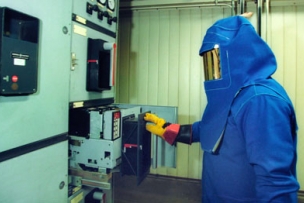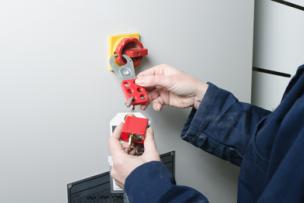When done correctly, proper lockout/tagout saves an estimated 50,000 injuries and 120 fatalities per year. But as Hank LaRocco of Zing Green Safety Products emphasizes, it’s not simply a matter of on or off. A detailed, step-by-step procedure must be put in place.
Preventing Injuries and Saving Lives with Proper Lockout/Tagout
The Occupational Safety and Health Administration has fairly clear-cut requirements for de-energizing equipment through lockout and tagout procedures in the workplace. So why do many manufacturing companies continue to receive citations for failing to comply with these requirements—and why do improper lockout/tagout procedures remain on the OSHA Top 10 list?
“Roughly 95 percent of all lockout/tagout citations involve the failure to have a formal energy control program in place,” explains Hank LaRocco, channel manager for Zing Green Safety Products, in a recent safety webinar presented by National Marker Company and MSC. “Improper lockout/tagout procedures remain at the top of OSHA’s list of most frequently violated standards. And those fines are large and firm.”
As LaRocco explains, lockout/tagout covers the servicing and maintenance of equipment in which the unexpected energization or startup of equipment or the release of stored energy could cause injury. OSHA standard 1910.147 helps to establish minimum performance requirements for controlling that hazardous energy. Per the standard, equipment installed after Jan. 2, 1990, must be designed to accept lockout to its energy-isolating device. Adhering to these requirements from OSHA won’t just help your company save time and avoid costly fines through citations—it’s also undoubtedly going to save lives, says LaRocco.
“The standard is intended to save 120 lives and prevent 50,000 injuries each year,” he explains. “Workers injured on the job from exposure to hazardous energy lose an average of 25 workdays for recuperation.”
To stay compliant, manufacturers must understand lockout and tagout and how to be in compliance, establish a written program that includes machine-specific procedures and conduct thorough employee training and equipment inspection.
Step 1: Establish Clear-Cut Compliance
One of the first things a safety manager can do to establish a lockout/tagout safety program is identify the energy sources (or isolation points) in a facility, says LaRocco. These sources include mechanical, hydraulic, electrical, gas, pneumatic, water, chemical, thermal, gravity and other stored points. To help isolate these points, OSHA has a formal six-step procedure to control the hazardous energy:
-
Notify and clear all affected employees.
- Shut down equipment.
- Isolate all related energy sources.
- Apply lockout/tagout devices (and use multiple devices if necessary).
- Control stored energy (and release stored electrical charges).
- Verify energy isolation (by trying out devices over and over).
By enacting these steps, another question will probably arise: Does the piece of equipment actually need a lock or tag?
“There are a few exemptions, including instances in construction, agriculture and maritime,” explains LaRocco. “These situations might also include oil and gas well drilling services. But most importantly, you must ask yourself: Is the employee required to remove or bypass a safety device in order to operate the equipment, or is he or she required to place any part of their hand into an area on the machine or equipment where it could be injured? If the answer is ‘yes’ to either of those two questions, you need to follow lockout/tagout procedures—no exceptions.”
Two types of workers can encounter your equipment daily––both requiring a different approach and procedure to locks and tags.
“An affected employee is a person who locks or tags out equipment in order to perform the task at hand––and they absolutely must be aware of what’s going on with his or her equipment’s lockout/tagout,” LaRocco stresses. “Alternatively, if it’s an affected employee who might just be a visitor or contractor passing through the plant, if they will be near the energized equipment, they need to be made aware of proper lockout/tagout procedures.”
As for choosing an energy-isolating device (or mechanical device that prevents the transmission or release of energy) for your equipment, LaRocco highlights manually operated electrical circuit breaks, disconnected switches, line valves, blocks or any similar device to block or isolate free energy.
“One question that often comes up in the field or during these webinars is if push buttons and switches are lockout or tagout devices, per OSHA regulation. They’re not,” he explains. “That’s not to say switches won’t be a part of your procedure, but it shouldn’t be the sole isolating point for your energy.”
Step 2: Draft a Detailed Energy Control Program
According to LaRocco, an effective energy control program must highlight five key points: scope, purpose, authorization, rules and techniques for lockout/tagout to enforce compliance.
“However, you need two particular programs,” he says. “First, you’ll need a program for your facility—a program that outlines scope and what the program is for. The second part is the more difficult part, which is writing machine-specific procedures for all equipment.”
That machine-equipment outline must include a statement of intended use for the procedure, specific steps for shutting down, isolating, blocking and securing equipment, steps for placement, removal and transfer of lockout or tagout device—and requirements for testing equipment.
“You have to take a look at each piece of equipment, what energy sources are driving them and what lockout devices should be on each one,” he explains. “For example, most larger pieces have hydraulic components, and some have electronic gas control. You need to identify an isolating point so the gas can’t come out. Each one of your machines needs a written procedure by itself.”
Above all, however, LaRocco stresses the importance of staying protected throughout the entire process. “The reason lockout and tagout programs were designed was to protect the people servicing them,” he says. “All the regulations beneath that are secondary. When you’re doing servicing, you have the sole personal protection of that piece of equipment. Nobody should be able to remove or bypass your lockout device. That’s strictly forbidden without a detailed set of reasons.”
Along with knowing which pieces of equipment need energy-isolation devices, safety managers should note some limitations associated with lockout/tagout in general.
“If a device can’t fit a lock, a tag can be used, but I don’t typically recommend a tag alone,” LaRocco advises. “Tags are limited in terms of how they’re manufactured. Take into account environmental conditions and chemicals. They usually have a 50-pound pullout, so it’s not easily removed. And in the case of an accident, you must demonstrate that the tag was as effective as the lock. If you could’ve put a lock on it without a tag, that makes it hard to demonstrate.”
"Roughly 95 percent of all lockout/tagout citations involve the failure to have a formal energy control program in place. Improper lockout/tagout procedures remain at the top of OSHA's list of most frequently violated standards. And those fines are large and firm."
Step 3: Enact a Comprehensive Inspection Timeline and Training Program
Without proper inspection and training, those carefully selected locks and tags will be rendered useless. Safety managers should evaluate their facilities annually, factoring in new equipment construction, installations, modifications, maintenance, repairs and staff changes.
“A facility should be continuously re-evaluating their lockout/tagout procedures, but especially when new personnel or employees enter the equation or there are changes in the floor or electric wiring layout,” LaRocco stresses. “Once a year, be sure to conduct a thorough review with the inspector and authorized employees.”
That same timely sentiment applies to employee training programs. “Training should be conducted once a year, but certainly more so when you have new employees who need to go through basic training,” LaRocco says. “This should be a part of your permanent records. At the end of a training session in the field, I’ll typically offer a certification for the employee. In the event of an incident, OSHA will see my training records. It’s a critical part of the training and a way to protect your business.”
Of course, an authorized employee will need more training than an affected employee. But no two affected employees will require the same training intensity and frequency.
“Contractors, for example, need to be hyperaware of the equipment you’re using,” LaRocco explains. “They need to know the procedures … it’s very important.” Any employee who makes contact with an energy point needs to know it exists. He points out that contractors must be informed of all applicable lockout/tagout procedures and that the employer and contractor must follow the same standard energy control program.
It’s not always the case that a single authorized employee is assigned to a specific piece of equipment. Several authorized individuals can have access to a device, making clear-cut lockout and tagout procedures pivotal.
“This typically happens with a larger piece of equipment. The trick to maintaining safety is to ensure each one of those employees is equipped with the same level of personal protection,” says LaRocco.
That same focus on protection applies to shift changes. A continuity of lockout/tagout protection must be ensured by following specific procedures for shift and personnel changes, including the orderly handoff of lockout, says LaRocco. For all employees involved, removal of a lockout/tagout device and subsequent startup is one of the most important components to training. LaRocco and his team suggest the following steps to ensure safety during removal:
- Check that nonessential items are removed from equipment.
- Ensure that equipment components are intact.
- Assess the area to ensure that all affected employees are removed.
- Notify all affected employees and the site supervisor before re-energizing equipment.
- Remove the lockout or tagout device.
- Re-energize equipment.
Lockout/tagout procedures have no shortage of steps and best practices, LaRocco says, but it’s not omitting one or two small details during the process that presents the most danger. It’s complete negligence and haste.
“After all we go through during trainings, accidents still happen,” he says. “In my area in the Midwest, I see 60 to 100 accidents per year. While some are unavoidable, some are the most unfortunate and preventable incidents you’ll see, with mostly people cutting corners or not understanding what to do in a procedure. It rarely happens because someone didn’t follow a small rule … it occurred because someone wanted to get something done as fast as they could.”
What steps does your company take to ensure employees follow a thorough lockout/tagout procedure? Let us know in the comments below!





Talk to Us!
Leave a reply
Your email address will not be published. Required fields are marked *